London Ambulance Service Defibrillator Accreditation Scheme
What is a cardiac arrest and what is a defibrillator?
When someone suffers a cardiac arrest, the heart stops. Blood is no longer being pumped around their body and they are clinically dead.
The longer they go without emergency life-support, the harder it is to restart their heart. That’s where you can make a difference.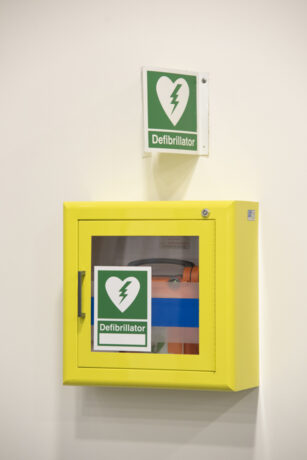
A defibrillator is a machine used to give an electric shock to restart a patient’s heart when they are in cardiac arrest. If there were more public access defibrillators, more people could get the life-saving shock as quickly as possible, giving them the best chance of survival.
The London Ambulance Service’s defibrillator accreditation scheme offers you formal guidance and support in buying, storing and using a defibrillator. This page provides you information on the requirements for defibrillator accreditation.
Why defibrillators are important
London Ambulance Service’s Chief Medical Officer Dr. Fenella Wrigley:
“A cardiac arrest is a serious medical emergency when someone’s heart has stopped beating. Over 10,000 people in London suffer a cardiac arrest every year. When this happens, every second counts and the key to survival is early chest compressions and early defibrillation.
“More public places need to have defibrillators. They are safe and simple to use and can significantly increase a person’s chances of survival.
“Making sure the public has easy access to defibrillators and the knowledge of basic life support skills will only help to save more lives.”
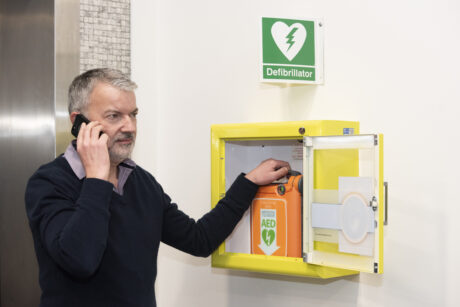
Criteria for accreditation
To become accredited as part of the scheme, you must meet all of the criteria detailed below:
1. Defibrillator – this must be a semi or fully automatic defibrillator operating according to the latest UK Resuscitation Council guidelines. Items such as the battery or defibrillator pads must be within their expiry date.
2. Storage – the defibrillator must be easily accessible and not locked away. The storage cabinet should be highly visible and its location marked with the UK standard defibrillator sign.
3. Training – staff at the location must be trained in using the defibrillator and training should be refreshed on an annual basis. An up-to-date list of trained staff and their certificates must be available.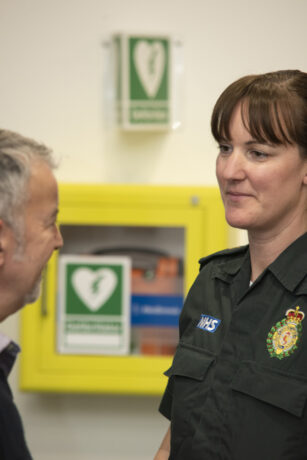
4. Checking – you must record that the defibrillator has been given a visual check at least once a week and a ‘switch-on’ test at least once a month.
The outcome of these checks must be recorded. Each location should have two nominated people who take responsibility for the defibrillator and their contact details should be provided to the London Ambulance Service.
5. Alerting – the accredited organisation must provide at least one telephone number so that the London Ambulance Service can advise of any serious emergency calls made near the defibrillator.
Accreditation will last for two years and you should contact us to renew your accreditation.
Read more on these criteria in the below drop-down boxes:
-
Defibrillator
We recommend either a fully automatic or a semi-automatic defibrillator. We would also advise that the defibrillator is equipped with two sets of electrode pads.
You will need to make your own decision as to your chosen supplier. The following manufacturers have defibrillators that are already in widespread use at public-access defibrillator sites across London and the models listed are in our experience suitable for public-access use.
Stryker
Web: www.strykeremergencycare.com
Email: [email protected]
Tel: 07976 508 974
- LIFEPACK CR2
Cardiac Science – part of the Zoll medical family
Web: www.cardiacscience.com
Email: [email protected]
Tel: 07887 617013
- Powerheart G5
- Powerheart G3 Elite
Whilst modern defibrillators are very reliable, there are consumable items that have an expiry date and must be replaced. These include electrode pads which can last between two to four years and vary in price dependent on the machine. The defibrillator battery lasts up to four years and costs approximately £200 to replace.
-
Storage
We recommend that the unlocked defibrillator storage cabinet should be high-visibility yellow (ideal colour is RAL 1016).
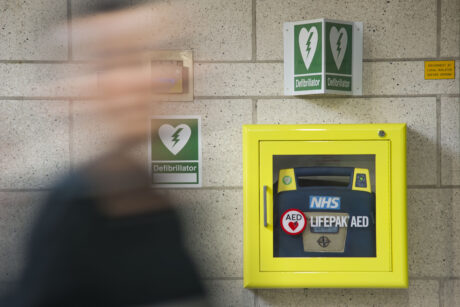
Suitable cabinets can be purchased from a number of manufacturers and you will need to make your own decision as to your chosen supplier.
The following suppliers are known to have provided cabinets in the recommended colour:
Stryker
- Web: www.strykeremergencycare.com
- Email: [email protected]
- Tel: 07976 508 974
Cardiac Science
- Web: www.cardiacscience.com
- Email: [email protected]
- Tel: 07887 617013
In some locations it might be more appropriate to use a defibrillator specific wall bracket rather than a cabinet.
If you meet the accreditation standard, you will be provided with a self-adhesive sign to indicate that your premises are a London Ambulance Service accredited site.
You should display the sign prominently at the entrance of your building so that visitors and passers by are aware that a defibrillator is available. The sign is double sided so it can be displayed on a window or other hard surface.
The defibrillator location should always be marked with the UK approved symbol. We will provide adhesive and rigid plastic signs.
-
Training
To maximise the chances of saving a life, everyone should be trained in cardiopulmonary resuscitation (CPR) and the use of the defibrillator. The UK Resuscitation Council recommends that all training should include practising on a life-sized training mannequin.
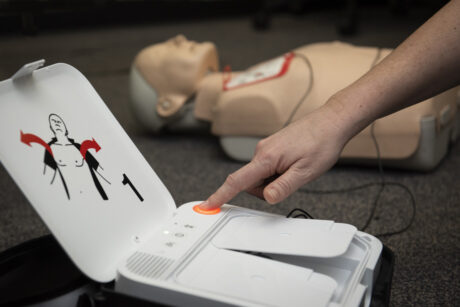
The London Ambulance Service can provide appropriate training which is delivered by our team all of whom have experience as frontline ambulance personnel.
These courses last for three hours for a maximum of twelve people and can be delivered anywhere in London. On completion of the course, participants will receive a certificate from the London Ambulance service.
Our experience shows that people who have this training have the confidence required to attempt resuscitation and as a result are more likely to save a patient’s life.
There are other training providers who can deliver training that meet our accreditation standards.
For further information and the cost of training, please call our team on 020 7783 2534 or email [email protected].
Information about CPR and defibrillator training can be found at the UK Resuscitation Council’s website and in their booklet “Cardiopulmonary Resuscitation and Automated External Defibrillation”
-
Checking
Every site must have two nominated people who are responsible for regular defibrillator checks. It is an accreditation requirement to provide the names, email addresses and telephone numbers for the two people.
Most modern defibrillators are designed to do an automatic self-check every 24 hours and its electronic display confirms the defibrillator’s readiness. Whilst defibrillators need their batteries and pads replaced they do not require any routine servicing or maintenance.
We require weekly and monthly checks to ensure the defibrillator is ready to use. These checks should take no more than five minutes and the outcome must be recorded. In the absence of an existing method of recording these checks, they can be recorded using the London Ambulance Service online checking system.
Weekly checks
- Check that the display indicates the defibrillator is working correctly and that the battery is charged.
- Check that the defibrillator pads have not reached their expiry date.
- Confirm check has taken place and the details are recorded.
Monthly checks
- Check that the display indicates the defibrillator is working correctly.
- Check that the defibrillator pads have not reached their expiry date.
- Switch on the defibrillator to confirm that it is working and switch off.
- Confirm check has taken place and the details are recorded.
Your site can only remain accredited if you regularly check the defibrillator.
-
Alerting
A defibrillator should always be taken to a seriously ill or injured patient but on occasions people responsible for the machine might be unaware of a 999 call.
With this in mind, we have developed an automatic alerting system. This informs you when there is a serious medical emergency nearby. As well as ensuring that someone with emergency life-support skills is alerted.
We will therefore require at least one direct dial telephone number that will be contacted in the event of a 999 call being made from the defibrillator site. These numbers can include the reception or security desk, a duty manager’s mobile and any on site medical personnel.
-
What we will provide
Accreditation
One of our team will arrange to visit your site. They will meet with your nominated staff, answer any questions you may have and assess your organisation against the accreditation criteria.
Once accredited, the organisation will receive a certificate, a memorandum of understanding signed by both parties, an accreditation badge to display in your property, and signs to indicate the location of the defibrillator.
Checking
We will provide accredited sites with access to our online checking system.
Alerting
We will automatically alert you to a serious medical emergency near the defibrillator location.
Support
Our team will provide advice and support to accredited sites. When a defibrillator is used, a call should be made to the Defibrillator Hotline on 020 7783 2365 at the earliest opportunity. We will visit your site to debrief those involved and answer any questions or concerns.
We will also expect to download the event details from the defibrillator as this can provide important information and assist the hospital in treating the patient.

Follow us on social media: